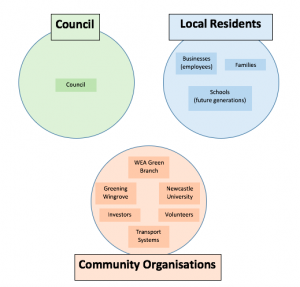This week we met with Jayne Hopkins, our project partner from Best of Bensham, with which we discussed our project brief and gained a greater understanding of the area of Bensham and its community.
We addressed the challenges and opportunities within Bensham as a starting point for our project focus, some of which included:
Challenges:
- Lack of financial resource amongst large proportion of population.
- Inaccessibility to shops for residents who don’t have access to a car.
- Unclean streets (Littering/ Vacant lots).
- Best of Bensham is unclear of its unifying theme.
- Best of Bensham is set on an asset-based approach but there is a lack of understanding about what this is.
Opportunities:
- Bensham is a very diverse area.
- The population possess many valuable skills (especially its affluent residents)/ knowledge.
- There is a large opportunity to achieve results with the locals within the next 12-18 months due to the current motivation surrounding the topic.
- There is a great interest in the creation of more outdoor spaces within Bensham, specifically focusing on garden areas for growing plants/ vegetables.
- The group ‘Best of Bensham’, is well-resourced regarding grant funding; can give 10 grants of up to £250 to smaller organisations (e.g. To churches running Christmas day dinners for those who don’t have family to share it with).
After identifying the challenges and opportunities within Bensham we established a key issue for us to concentrate on, which was to help the residents of Bensham express their needs and aspirations for their community.
We then discussed potential stakeholders in the project, which we identified consisted of a few main groups:
- Gateshead Council; Including Neighbourhood Management Services.
- Local Community Groups/ Voluntary Organisations.
- Business Owners and Private Landlords.
Our stakeholders influenced the next steps in our project, which were to determine a number of activities which would help us in developing our research further. We decided to arrange some next steps regarding our project plan which were to organize a series of interviews/ meetings with known residents and community members who are involved in the community activity in their area, and one member of the council. These include people such as, Dave Andrew, Phil Donovan and Robert and Marilyn Rae. The aims of these meetings are to gain knowledge about residents’ opinions of Bensham, relating to the challenges and opportunities we have discussed and learn their thoughts on residents’ ability to express their opinions about the community, as well as the councils point of view regarding the matter.
There was also some mention of conducting a workshop which the general public of Bensham could get involved with to share their opinions on the matter. This approach was considered to be potentially more effective than individually questioning members of the public on the streets yet would be a challenge to organize.
We also decided it would be a good idea for some of us to conduct a site visit and take photographs of the area so we could better understand the characteristics of the location, such as the amount of green/ outdoor space in the area, number of vacant lots and the levels of litter throughout the streets.
Here are our mind maps regarding the challenges and opportunities identified within Bensham, our stakeholder and process map, and our initial suggestions for project actions.







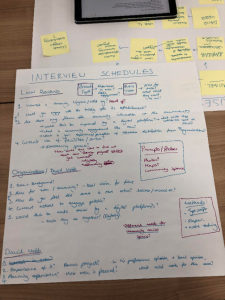
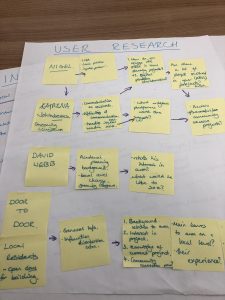
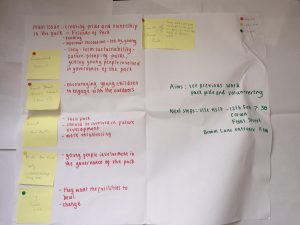
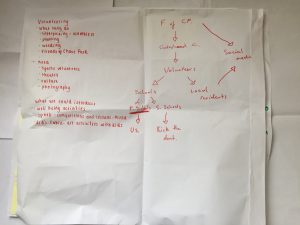
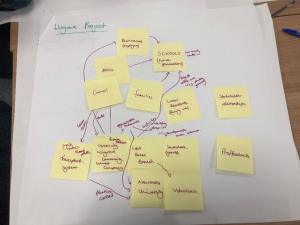 We began by naming the main stakeholders such as families, local residents, community organisations and WEA Green Branch, then branching off from these, connecting in other local groups. We discovered that the WEA Green Branch would have a link with the Greening Wingrove Community Interest Company and also with investors (who provide grants for events and developments). Volunteers and students from Newcastle University were also interlinked within this group as they would help provide support for many of the events done by WEA and Greening Wingrove. Another connection was found between the WEA and schools in the area, as education centres are a central hub for community connection. We felt having schools as one of the key stakeholders would help disburse information more effectively. Lastly, from schools there comes a link with families, the police, businesses and the council, therefore creating a bridge between the different interest groups within the area.
We began by naming the main stakeholders such as families, local residents, community organisations and WEA Green Branch, then branching off from these, connecting in other local groups. We discovered that the WEA Green Branch would have a link with the Greening Wingrove Community Interest Company and also with investors (who provide grants for events and developments). Volunteers and students from Newcastle University were also interlinked within this group as they would help provide support for many of the events done by WEA and Greening Wingrove. Another connection was found between the WEA and schools in the area, as education centres are a central hub for community connection. We felt having schools as one of the key stakeholders would help disburse information more effectively. Lastly, from schools there comes a link with families, the police, businesses and the council, therefore creating a bridge between the different interest groups within the area.